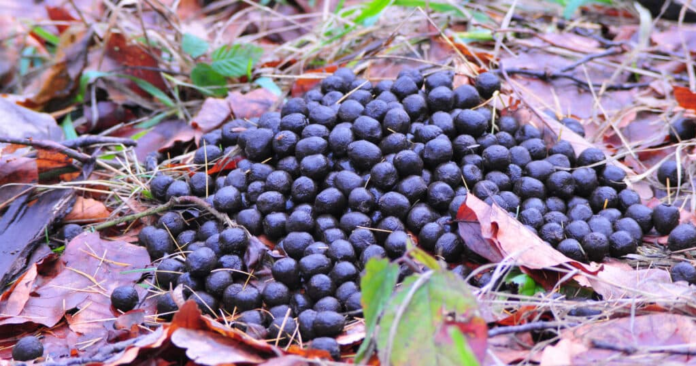Introduction
You’re out for a hike in the woods or maybe scouting your property, and suddenly, you spot it—a pile of deer poop. While it might not be the most glamorous topic, deer droppings can tell you a lot about the local wildlife, the health of the deer population, and even provide clues about how to track these elusive creatures. Whether you’re a hunter, a nature enthusiast, or just curious, understanding deer poop is surprisingly valuable. In this guide, we’ll dive deep into everything you need to know about deer droppings. We’ll explore what deer poop looks like, why it matters, and how it compares to other animal droppings. Plus, we’ll discuss the fascinating ways people use deer droppings in gardening, and how to interpret the signs they leave behind.
What Does Deer Poop Look Like?
Deer poop is relatively easy to identify once you know what to look for. Typically, deer droppings are small, pellet-like, and dark brown or black in color. Each pellet is usually about the size of a jellybean, roughly 1 to 2 centimeters long. However, the size and shape can vary depending on the deer’s diet and health.
- Color: The color of deer poop can range from dark brown to almost black. Fresh droppings are usually darker and shinier, while older droppings fade and become drier. The color can also change based on what the deer has been eating. A diet high in fruits, for example, can result in lighter brown droppings.
- Shape: Deer droppings are typically round or oval-shaped pellets. In some cases, especially when deer have been feeding on lush vegetation, the pellets can stick together, forming larger clumps.
- Texture: Fresh deer droppings are firm and moist, while older droppings become dry and crumbly. The texture can also give clues about the deer’s diet. For example, a diet rich in fibrous plants will produce harder, more compact droppings.
Comparison with Other Animal Droppings
To the untrained eye, deer poop might be confused with the droppings of other animals, such as rabbits, elk, or moose. However, there are key differences:
- Rabbit Droppings: Rabbit poop is also pellet-like but is generally smaller and more uniform in shape. Rabbit pellets are usually lighter in color, often a medium brown, and have a rougher texture.
- Elk Droppings: Elk poop is similar in shape to deer droppings but larger, with each pellet being about twice the size of a deer pellet. The color is usually the same dark brown or black.
- Moose Droppings: Moose droppings are much larger than deer droppings, often the size of a small grape or marble. They are also oval but more elongated and less uniform than deer pellets.
Why Deer Poop Matters
Understanding and identifying deer poop is not just a quirky skill—it can be incredibly useful for various reasons:
- Tracking Deer: For hunters and wildlife enthusiasts, deer droppings are a valuable sign that deer are nearby. Fresh droppings indicate that deer have recently passed through the area, while older droppings suggest they may have moved on. By analyzing the quantity and freshness of droppings, you can gauge the size and activity level of the local deer population.
- Deer Health: The condition of deer droppings can offer insights into the health of the deer population. For instance, unusually soft or watery droppings might indicate that the deer are sick or stressed. Consistently small or hard pellets could suggest that the deer are not getting enough nutrition.
- Understanding Deer Behavior: Deer droppings can also help you understand deer behavior and patterns. For example, large quantities of droppings in one area might indicate a feeding or bedding spot. By studying these patterns, you can learn more about where deer are likely to be found at different times of the day.
Deer Poop and Gardening
One of the lesser-known uses of deer poop is as a natural fertilizer. Like other types of manure, deer droppings are rich in nutrients that can benefit your garden. However, there are some important considerations to keep in mind:
- Nutrient Content: Deer poop is high in nitrogen, which is essential for plant growth. It also contains other valuable nutrients, such as phosphorus and potassium. When composted, deer droppings can help improve soil fertility and promote healthy plant growth.
- Composting: It’s important to compost deer poop before using it in your garden. Fresh deer droppings can carry harmful pathogens that could contaminate your plants. Composting helps to kill off these pathogens and breaks down the manure into a more usable form. A compost pile should be turned regularly and allowed to decompose for at least six months before using the manure in your garden.
- Application: Once composted, deer manure can be applied to your garden like any other compost. It’s particularly beneficial for heavy-feeding plants like tomatoes, corn, and squash. Simply spread the composted manure around the base of your plants and lightly work it into the soil.
How to Interpret Deer Droppings
Deer droppings can provide a wealth of information if you know how to interpret them. Here are some tips:
- Freshness: Fresh droppings are dark, moist, and shiny, while older droppings are lighter in color and dry. By assessing the freshness of the droppings, you can estimate how recently the deer were in the area.
- Quantity: A large number of droppings in one spot may indicate a feeding or bedding area. Deer often defecate while resting or grazing, so finding a concentration of droppings can help you identify these critical areas.
- Diet: The appearance of the droppings can tell you something about what the deer have been eating. For example, loose, clumped droppings might suggest a diet high in soft, succulent plants, while hard, compact pellets indicate a diet rich in fibrous materials like twigs and leaves.
Common Myths and Misconceptions About Deer Poop
There are several myths and misconceptions about deer poop that are worth addressing:
- Myth #1: Deer Droppings Can Always Be Used as Fertilizer Without Composting: While deer poop is rich in nutrients, it should not be used fresh in your garden. Fresh deer droppings can carry pathogens that could harm your plants or even pose a risk to human health. Always compost deer manure before using it as fertilizer.
- Myth #2: The Size of Deer Droppings Reflects the Size of the Deer: Some people believe that larger deer produce larger droppings, but this isn’t necessarily true. The size of deer droppings is more influenced by the deer’s diet and hydration levels than by the size of the deer itself.
- Myth #3: Deer Only Poop in Certain Areas: Deer are creatures of habit and will often return to the same areas to feed or rest, but they don’t have specific “pooping grounds.” Deer defecate as they move, so you can find droppings almost anywhere in their habitat.
Comparing Our Guide with Competitor Content
In analyzing the content provided by the competitor links, it’s clear that while they cover the basics of deer droppings, they often fall short in depth and detail. Here’s how our guide goes beyond:
- Comprehensive Coverage: Unlike the articles found on Outdoor Life, Adobe Stock, and iStock, our guide offers a complete overview of deer poop, including identification, uses, and interpretation. We delve into the details of how to distinguish deer droppings from those of other animals, which is not covered comprehensively in competitor articles.
- New Information: We provide new and unique insights, such as the use of deer droppings in gardening and the common myths surrounding deer poop. This content is not found in the competitor articles, offering readers added value and knowledge.
- Better Structure: Our guide is structured in a way that is easy to follow, with clear subheadings and bullet points that make the content more digestible. The competitor articles tend to be less organized, making it harder for readers to find the specific information they’re looking for.
- Engaging Style: We’ve written this guide in an engaging and accessible style, using humor and informal language where appropriate. This approach makes the content more relatable and enjoyable to read, which is often lacking in more clinical or technical competitor content.
Conclusion
Deer poop might not be the most glamorous subject, but it’s one that offers surprising insights into the world of wildlife. From identifying the presence of deer to understanding their health and behavior, deer droppings can tell you more than you might expect. Whether you’re a hunter, gardener, or simply curious, knowing how to identify and interpret deer poop is a valuable skill. We hope this guide has provided you with all the information you need—and perhaps a little more than you ever thought you’d want to know—about deer droppings. So the next time you’re out in the woods and come across a pile of pellets, you’ll know exactly what it means.




